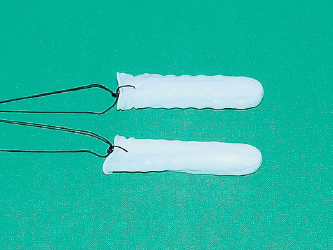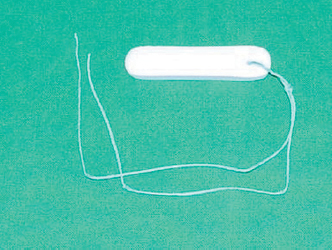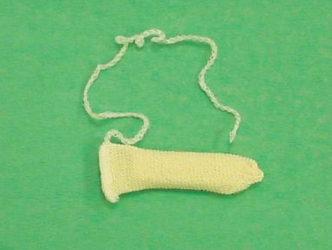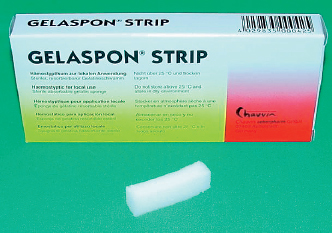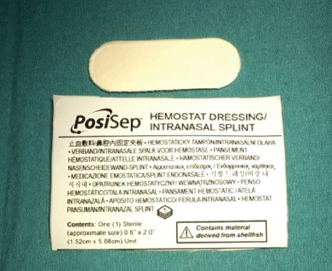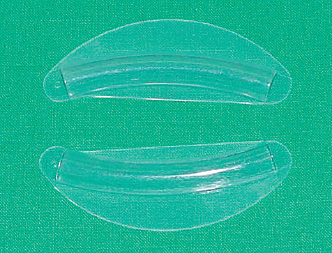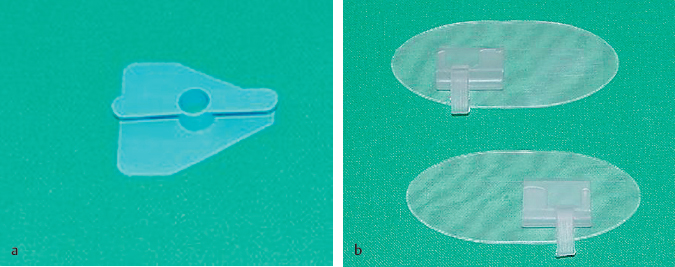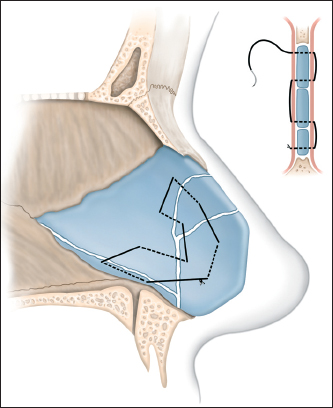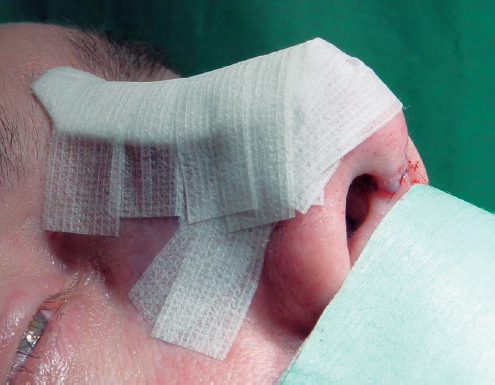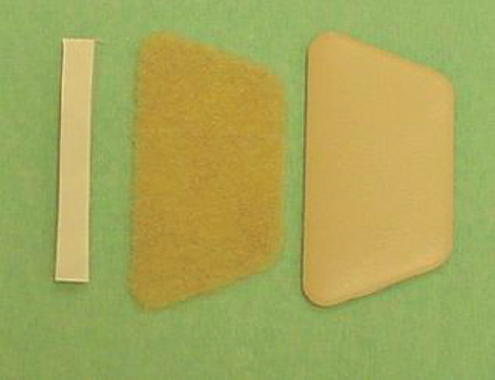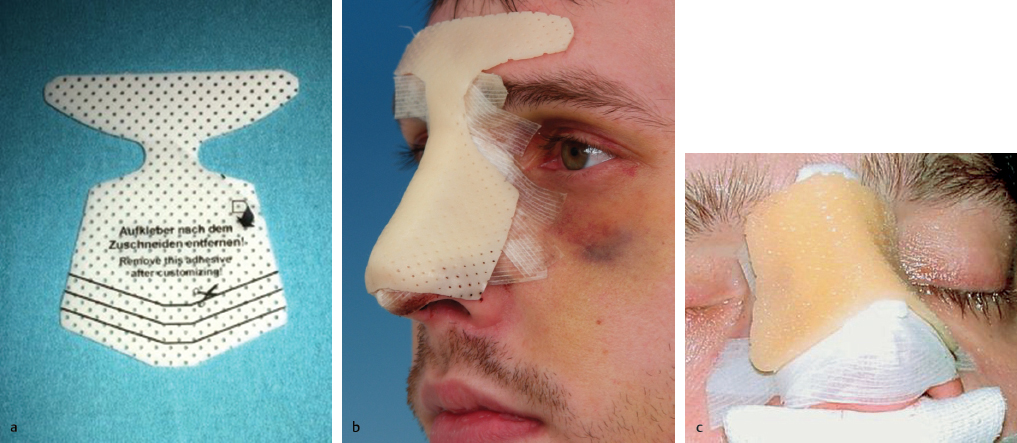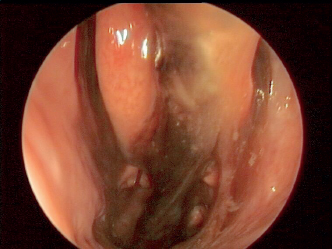Chapter 15 The common practices used in the perioperative care of patients undergoing septorhinoplasty are diverse and controversial. A consensus statement on the preferred clinical pathway in the perioperative treatment of patients undergoing septorhinoplasty has yet to be approached formally. It is obvious that perioperative care and practices after nasal surgery vary among the most highly trained and leading rhinoplasty surgeons.1 The following guidelines are recommendations that should be coincided with own practiced course of treatment after septorhinoplasty. Postoperative treatment usually begins with the application of intranasal packs and the application of an external dressing. Removal of the packs and dressing does not mark the end of postoperative care.2 On the contrary, it is essential to maintain diligent surveillance of intranasal and extranasal wound healing dynamics. In the early postoperative period, the nasal surgeon should observe and support wound healing with specific manipulations. He should instruct the patient in how to protect the result with proper conduct and self-care. Endonasal care is particularly important after surgical procedures involving the combined treatment of chronic inflammatory sinus diseases, septal deformities, turbinate hyperplasias, and osseocartilaginous morphological variants.3,4 With minimally invasive operative techniques, it is possible to combine functional endoscopic sinus surgery procedures with rhinoplastic procedures, thereby achieving different treatment goals in one operation. This requires a postoperative regimen that is geared toward preventing early and late complications and, if they occur, can ensure the rapid institution of appropriate treatment. The function of intranasal packs is to provide appropriate tissue compression to approximate the wound surfaces and prevent swelling, bleeding, and hematoma formation. The physiological wound healing should be supported by establishing a moisty milieu that can help to accelerate epithelialization and to reduce granulation and scar formations.5 These goals are particularly important when there are large, open wounds in the mucosa, like those resulting from endoscopic sinus surgery or a strip turbinectomy. Basically, a pack after sinus surgery can be avoided by minimal mucosa traumatization and meticulous bleeding control.6–10 Because there is only a limited evidence of beneficial effect by packs, many nasal surgeons never use nasal packing after septorhinoplasty.1,11 Packing materials for sinus or turbinate wound surfaces are placed temporarily and some kind of them are generally removed after a period of 1 to 3 days.12 These include Silastic-coated foam packs (Rhinotamp; Fig. 15.1), selfexpanding polyvinyl acetate packs (Merocel; Fig. 15.2), and hydrogel-coated packs (Rapid Rhino; Fig. 15.3). One of the main selection criteria should be minimal adhesion to the mucosa with a good hemostatic action. Pack removal should be painless and should not damage the mucosa. Packs with slick or gel-like surface provide a measurably better comfort to patients and less pain and bleeding during removal.13–17 Another option is to use hemostyptic packing materials as biodegradable materials that liquefy as wound healing progresses.18 Remnants can be removed by means of suction during postoperative care. This eliminates the pack-removal procedure that patients dread. These materials include gelatin sponge (Gelfoam, Gelaspon; Fig. 15.4), hyaluronic acid (Merogel), carboxymethylcellulose (Tabotamp), and chitosan-dextran gel (PosiSep; Fig. 15.5). Side effects like increased rates of granulations, scar formations, and new bone formations had been shown after the use of these materials.10,19–21 An advantage was reported that after the use of carboxymethylcellulos,22 hyaluronic acid,23 and chitosan-dextran gel,24 a lower rate of synechias had been demonstrated, but no advantages in terms of wound healing parameters or postoperative bleeding rates.25–27 Internal splints are designed to keep reconstructed portions of the septum from dislodging and prevent hematoma formation about the septum. They are also used to prevent synechia formation between wound surfaces.28,29 The most commonly used splints are Doyle nasal airway splints (Fig. 15.6) and Reuter Silastic (Fig. 15.7) or Teflon splints. Specially molded stents can be used to maintain the patency of enlarged passages in functional endoscopic sinus surgery (Fig. 15.8a, b). Fig. 15.1 Silastic-coated foam strips with attached threads (Rhinotamp), used in packing the ethmoid or inferior nasal meatus. Fig. 15.2 Polyvinyl acetate pack with attached thread (Merocel). The material expands on contact with blood, exerting a compressive effect on the mucosa. Fig. 15.3 Hydrogel-coated pack with attached thread (Rapid Rhino). The pack can be placed in the ethmoid or inferior meatus. When the pack is moistened, it exudes a gel that promotes platelet aggregation for hemostasis. It is wrong to expect internal packing to salvage a poor postoperative result in the septum, sinus ostia, or external nasal shape. Also, a pack that fits too tightly or is too long will interrupt venous and lymphatic drainage, resulting in unnecessary swelling. The duration of septal splinting and the danger of submucous hematoma formation can be reduced by placing multiple transseptal mattress sutures (Fig. 15.9). Good results can be achieved with double-armed 4–0 Vicryl sutures (Johnson & Johnson Medical GmbH) on a straight needle.30,31 The function of the external dressing is to secure the mobilized skin on the cartilaginous and bony nasal framework. It should reduce potential spaces that may fill with blood or serum, leading to hematomas and swelling. The external dressing should also protect the mobilized nasal segments from displacement due to external trauma or intranasal swelling. Like the internal dressing, the external dressing cannot salvage a technically poor result due, for example, to inadequate osteotomies or resections. Before the external dressing is applied, postoperative edema and blood residues should be massaged from the nasal dorsum so that the result can be assessed. The principle of “what you see is what you get” applies.32,33 The external dressing should consist of at least two layers: a skin-friendly adhesive dressing and a firm nasal splint. The adhesive dressing for the skin consists of several, slightly overlapping adhesive strips that are placed across the nasal dorsum from the root of the nose to the supratip area.2,32–36 They are applied over a Gelfoam strip about 0.5 cm wide that is first placed along the full length of the nasal dorsum. This will facilitate dressing changes. One or two longer adhesive strips are slung over the nasal tip without obstructing the nares (Fig. 15.10). Various materials can be used for the nasal splint. Plaster cast materials are widely used and are easily shaped to fit the individual nose. One disadvantage of casts is that they adhere poorly to the adhesive dressing, and the dressing will tend to loosen as swelling subsides, often requiring additional fixation. Malleable aluminum splints are also available. The Denver splint (Summit Medical, Inc.) (Fig. 15.11) is supplied in three pieces—an adhesive tape to which an aluminum splint is attached with Velcro, padded by a foam strip. Thermoplastics37 can be trimmed to match the nasal size and can be accurately molded to the postoperative shape. Preshaped thermoplastic splints are supplied with an adhesive surface and adhere well to the adhesive dressing. Special preshaped thermoplastics (bess|rhino Thermo-Splint) consisting of malleable small plate for the front and a small bridge to cover the nasion had shown good results in reduction of postop swellings especially after bony reduction in the nasofrontal angle. An adherent foil with markings helps to shape the optimal size of the external splint (Fig. 15.12a, b). The splint covers the nasal dorsum, the nasal tip, and two-thirds of the caudal margin of the alar cartilage (Fig. 15.12c). A splint that fits too tightly can cause ischemia in the dorsal nasal skin. If pain is reported, therefore, the splint should be changed without delay. Normally the external dressings are removed at 1 week. The dressing may be extended an additional week, depending on the degree of swelling and the extent of the corrections. Fig. 15.6 Doyle intranasal splints. The Silastic splints are positioned on the septal mucosa and secured. The small tubes allow for minimal nasal airflow and allow secretions to be suctioned from the nose and nasopharynx. Fig. 15.9 Principle of mattress suture placement in the septum. The sutures largely prevent the formation of a septal hematoma and give the corrected septum additional stability. They also permit early removal of the septal splints. Fig. 15.10 External nasal dressing with skin-friendly adhesive tapes (Steri-Strips [3M]). Several overlapping strips are placed across the nasal dorsum, and two longer strips are slung over the nasal tip. A Gelfoam strip has been placed on the nasal dorsum beneath the dressing. Fig. 15.11 Denver splint set, consisting of an adhesive strip with Velcro and an aluminum strip, also with Velcro. All solid packings should be removed from the nasal cavity and, if placed, also from the ethmoid after sinus surgery or from the inferior turbinate after a turbinectomy on the first postoperative day. Pack removal must be done carefully, and spraying pantocaine and naphazoline into the nose will facilitate the procedure.38,39 Slight postoperative bleeding causes blood to collect in the nasal cavity. This blood coagulates and dries, forming blackish crusts. Sinus operations are followed by mucous drainage from the opened sinus, which also dries to form crusts (Fig. 15.13). Serous and mucous wound secretions collect on the floor of the nasal cavity and in the sinuses. Patchy fibrin deposits form on surgical mucosal defects, especially on the turbinates, and dry to form crusts (Figs. 15.14 and 15.15). Most patients are unfamiliar with the typical changes that occur after their operation. They should be given strict instructions that will help to reduce complications during the postoperative period. These instructions are outlined below:
Postoperative Care and Management
15 Postoperative Care and Management
15.1 Introduction
15.2 Intraoperative Management
15.2.1 Internal Dressing
Packs
Splints
15.2.2 External Dressing
15.3 Postoperative Management
15.3.1 First Postoperative Day
15.3.2 Early Postoperative Period
 The face should be rested for up to 8 days after the operation. Excessive facial movements (e.g., prolonged talking, chewing hard foods, vigorous laughter) should be avoided.
The face should be rested for up to 8 days after the operation. Excessive facial movements (e.g., prolonged talking, chewing hard foods, vigorous laughter) should be avoided.
Stay updated, free articles. Join our Telegram channel

Full access? Get Clinical Tree


